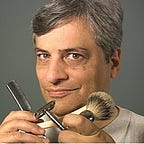A few weeks ago I was trawling some old data from the shave forums and and I came across a thread about using witch hazel as a pre-shave. I was intrigued so I decided to investigate further.
What Is Witch Hazel?
From Wikipedia:
Witch-hazels or witch hazels (Hamamelis) are a genus of flowering plants in the family Hamamelidaceae, with three species in North America (H. ovalis, H. virginiana, and H. vernalis), and one each in Japan (H. japonica) and China (H. mollis). The North American species are occasionally called winterbloom.
The main phytochemicals in witch-hazel leaves are polyphenols, including 3–10% tannins, flavonoids, and up to 0.5% essential oil, while the bark has a higher tannin content. Hamamelis water, also called white hazel or witch hazel water prepared from a steam-distillation process using leaves, bark or twigs, is a clear, colorless liquid containing 13–15% ethanol having the odor of the essential oil, but with no tannins present. Essential oil components, such as carvacrol and eugenol, may be present.
As an ingredient and topical agent, witch-hazel water is regulated in the United States as an over-the-counter drug for external use only to soothe minor skin irritations
Benefits Of Witch Hazel
Over the years there have been many claims of what witch hazel can do. However there are only two benefits of applying witch hazel topically to the skin that have reliable scientific data:
- Witch hazel relieves mild skin irritation like insect bites, eczema, psoriasis, diaper rash, and hemorrhoids. It can also treat scalp itchiness and irritation..
- Witch hazel reduces minor bleeding.
Some research (the animal or test tube variety) has suggested topically-applied witch hazel can also be helpful for:
- Acne.
- Sunburn and oxidizing air pollution.
- Viral infections.
- Ingrown nails.
Cautions Of Using Witch Hazel On The Skin
Witch hazel can cause skin issues if used too frequently (particularly the high-alcohol version, see the next section below). You should only use witch hazel a few times a week to avoid over-drying or stripping away the skin’s natural protective barrier.
Toner Vs. Astringent
Witch hazel can be a toner or an astringent depending on the level of alcohol in the individual product. What is the difference between a toner and an astringent? Both can cleanse the skin but astringents remove more oil from the skin than and are typically antibacterial. Toners can help balance the skin’s pH and help hydrate the skin.
Astringent witch hazel is produced by distillation using alcohol, which accounts for high level of alcohol in the product (typically about 15%). Low-or-no alcohol witch hazel can be achieved through water-steam distillation of the recently cut and partially dried portions of the plant. The downside is that you don’t get a complete spectrum of beneficial compounds like you do from alcohol-distilled versions of witch hazel but it is said that it results in a less effective product.Sponsored Links
Most low-cost witch hazel products you find in mass-market stores will be the astringent variety.
Using Witch Hazel Before Shaving
[Note: Amazon, Smallflower, and West Coast Shaving links are affiliate.]
I first tried using a “regular” (astringent) witch hazel, a house-brand from the local mega-mart. I experimented using it in a few variations like wiping down with a cotton ball then shaving normally, and wiping down followed by rinsing off before shaving.
The results were mixed and not encouraging: when I did this right after showering I didn’t really notice a difference in my shave. If I waited until later in the day and used a face cleanser followed by the astringent witch hazel I thought my shaves were a bit less comfortable-feeling, and I still didn’t notice any significant change in the performance of my shave.
However when I switched to a toner witch hazel (I used Thayers), either after a shower or after using a face cleanser, I did notice a difference in the performance of my shave–not much, but there was definitely less irritation in my “trouble areas” (for me, under my right jaw near the chin) and more of a smooth-feeling finish to my skin.
I also went back to my stash of shaving products to see what I could find and discovered two before-shave products that I get good results from also have a significant concentration of witch hazel: Castle Forbes pre-shave and Bevel Face Wash.
Using Witch Hazel After Shaving
The benefits of using witch hazel after shaving has been pretty well established: it helps to reduce redness and inflammation, as well as prevent ingrown hairs. It is also known for its healing properties, which can help with any cuts or nicks from shaving.
Conclusion — Witch Hazel And Shaving
I suggest giving witch hazel a try. It’s easy to find in most grocery stores and doesn’t break the bank when it comes time for a new bottle. It may not give you a better result as a pre-shave but it certainly a classic, traditional product with a lot of uses.
If you decide to give witch hazel as a pre-shave a try, leave a comment below with your findings!
